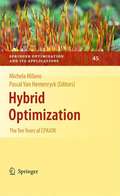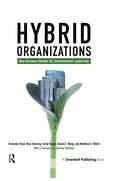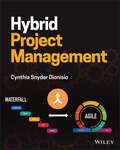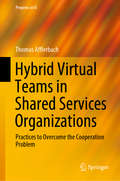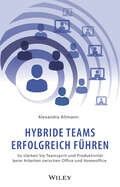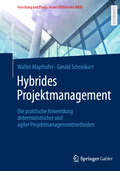- Table View
- List View
Hybrid Inflation Targeting Regimes
by Scott Roger Jorge Restrepo Carlos GarciaA report from the International Monetary Fund.
Hybrid Intelligence: Merging Collective and Artificial Intelligence to Solve Complex Problems
by Kevin HoltUniquely aimed at teams that think together to solve problems and make decisions, this book explains how to enhance the collective intelligence of a team-size group and combine it with the artificial intelligence (AI) of generative AI to create a hybrid intelligence that is smarter than either one on its own.Boards, committees, and other team-size groups of 5-20 people are the primary problem-solving and decision-making units within organizations, and they form the bridges between organizations, industries, and nations that collaborate on projects. So how can leaders exponentially improve their teams’ capabilities? Assemble the right people, arm them with the right processes, and execute those processes on the right platforms—then add generative AI to enhance those practices. This book describes and synthesizes various ways of increasing a group’s collective intelligence through people, process, and platform practices, and goes on to explain how to augment the practices with generative AI, including how to ask it questions and what questions to ask to obtain superior answers. The resulting upsurge in team capability enables organizations to survive and thrive in a world that is growing progressively more competitive and complex.This book will become the definitive resource for leaders and managers of commercial, government, and nonprofit organizations who want to learn how to significantly improve their teams’ problem-solving and decision-making ability by increasing their collective intelligence and combining it with the artificial intelligence of generative AI.
Hybrid Intelligent Technologies in Energy Demand Forecasting
by Wei-Chiang HongThis book is written for researchers and postgraduates who are interested in developing high-accurate energy demand forecasting models that outperform traditional models by hybridizing intelligent technologies. It covers meta-heuristic algorithms, chaotic mapping mechanism, quantum computing mechanism, recurrent mechanisms, phase space reconstruction, and recurrence plot theory. The book clearly illustrates how these intelligent technologies could be hybridized with those traditional forecasting models. This book provides many figures to deonstrate how these hybrid intelligent technologies are being applied to exceed the limitations of existing models.
Hybrid Knowledge in the Early East India Company World (Cambridge Imperial and Post-Colonial Studies Series)
by Anna WinterbottomHybrid Knowledge in the Early East India Company World presents a new interpretation of the development of the English East India Company between 1660 and 1720. The book explores the connections between scholarship, patronage, diplomacy, trade, and colonial settlement in the early modern world. Links of patronage between cosmopolitan writers and collectors and scholars associated with the Royal Society of London and the universities are investigated. Winterbottom shows how innovative works of scholarship – covering natural history, ethnography, theology, linguistics, medicine, and agriculture - were created amid multi-directional struggles for supremacy in Asia, the Indian Ocean and the Atlantic. The role of non-elite actors including slaves in transferring knowledge and skills between settlements is explored in detail.
Hybrid Manufacturing Processes: Physical Fundamentals, Modelling and Rational Applications (Springer Series in Advanced Manufacturing)
by Wit Grzesik Adam RuszajThis book explores, in a systematic way, both conventional and unconventional material shaping processes with various modes of hybridization in relation to theory, modelling and industrial potential. The demand for high productivity and high accuracy in manufacturing is continuously increasing, based on improvement and optimization strategies. Hybridization of manufacturing processes will play a crucial role and will be of a key importance in achieving environmental and economical sustainability.Structured in three parts, Hybrid Manufacturing Processes summarizes the state-of-the art hybrid manufacturing processes based on available literature sources and production reports. The book begins by providing information on the physical fundamentals of the removal and non-removal processes in macro-, micro and nanoscales. It then follows with an overview of the possible ways of hybridization and the effects on the enhancement of process performance, before concluding with a summary of production outputs related to surface integrity, specifically with respect to difficult-to-machine materials.Considering the applications of different sources of hybridization including mechanical, thermal and chemical interactions or their combinations, this book will be of interest to a range of researchers and practicing engineers within the field of manufacturing.
Hybrid Modeling and Simulation: Conceptualizations, Methods and Applications (Simulation Foundations, Methods and Applications)
by Navonil Mustafee Masoud FakhimiThe unique book advances understanding of modelling complex systems using hybrid approaches that combine discrete-event, agent-based, and system dynamic simulations with research approaches and artefacts from other scientific disciplines. As systems become increasingly large and complex, it is a challenge to capture the intricacies of the underlying system and offer novel forms of analysis using only models that employ a single simulation technique. The book underscores the importance of both hybrid simulation (employing techniques primarily developed in the field of modelling and simulation) and hybrid modelling (incorporating simulation with methods from wider disciplines such as applied computing, data science, engineering, and soft/qualitative operations research). Furthermore, the text aims to inspire further research and practice, fostering the growth of cross-disciplinary hybrid models. Topics and features: Provides a comprehensive overview of hybrid modelling and simulation, including methodological extensions and novel applications Features case studies and examples demonstrating the synergy realized by applying hybrid methods Calls for innovation and growth of the discipline by incorporating diverse scientific perspectives Encourages adoption of interdisciplinary methods to engender improved insights from simulation studies Promotes interdisciplinary collaboration, pushing modelling and simulation into new research and application areas This comprehensive volume will appeal to researchers, academics, students, and practitioners who seek to advance their modelling and simulation work. The book also will serve as a reference, informing research communities of the potential of hybrid models that combine simulation with disciplinary research artefacts, methods, and approaches.
Hybrid Optimization: The Ten Years of CPAIOR (Springer Optimization and Its Applications #45)
by Pascal Van Hentenryck Michela MilanoHybrid Optimization focuses on the application of artificial intelligence and operations research techniques to constraint programming for solving combinatorial optimization problems. This book covers the most relevant topics investigated in the last ten years by leading experts in the field, and speculates about future directions for research. This book includes contributions by experts from different but related areas of research including constraint programming, decision theory, operations research, SAT, artificial intelligence, as well as others. These diverse perspectives are actively combined and contrasted in order to evaluate their relative advantages. This volume presents techniques for hybrid modeling, integrated solving strategies including global constraints, decomposition techniques, use of relaxations, and search strategies including tree search local search and metaheuristics. Various applications of the techniques presented as well as supplementary computational tools are also discussed.
Hybrid Organizations: New Business Models for Environmental Leadership
by Andrew J. Hoffman Brewster Boyd Nina Henning Emily Reyna Daniel Wang Matthew WelchThis book offers a glimpse into the future. The companies it describes are pioneers, the first-movers in market shifts that will eventually become mainstream. These "hybrid organizations" – or what others call "values-driven" or "mission-driven" organizations – operate in the blurry space between the for-profit and non-profit worlds. They are redefining their supply chains, their sources of capital, their very purpose for being; and in the process they are changing the market for others. Using a combination of high-level survey analysis and, more importantly, in-depth executive interviews, the book helps fill the present gap in literature on environmentally focused and financially driven for-profit businesses. Moreover, it highlights key trends and critical themes that enable this new wave of socially conscious and fiscally minded enterprises to be successful in meeting both sets of goals. The takeaway for readers of this book is not only an appreciation for common business practices that hybrid organizations adopt, but also an understanding of the complexity of the integration of such adoption that allows them to successfully achieve both mission- and market-driven goals. The book begins with key definitions to establish the scope of this new sector, including explicit definitions for hybrid organizations, environmental sustainability missions, as well as specific criteria to create useful boundaries for the field of hybrid organizations. Building on prior work conducted by researchers on corporate social responsibility, sustainable entrepreneurship, and social enterprise, the book catalogues the best practices within this growing sector, helping others to learn from both the successes and failures of those that are choosing this strategy. The core of the book is built on an analysis of survey data from 47 hybrid organizations, investigating their business models and strategies, finances, organizational structures, processes, metrics, and innovations. The organizations represent a cross-section of size, age, industry, and geography, although the sample set is biased towards young, small, U.S.-based hybrids. Based on analysis of the survey data, five best-in-class companies were selected for in-depth case studies in order to provide instructive lessons for hybrid practitioners and researchers alike. In short, this book presents research that shows hybrid organizations to be a practical and feasible organizational model for contributing solutions to global environmental issues. The lessons in this book will help other social entrepreneurs, business managers, non-profit leaders, or students interested in careers that fuse profitability and responsibility do it even better.
Hybrid Predictive Control for Dynamic Transport Problems
by Alfredo Nunez Doris Saez Cristián E. CortésHybrid Predictive Control for Dynamic Transport Problems develops methods for the design of predictive control strategies for nonlinear-dynamic hybrid discrete-/continuous-variable systems. The methodology is designed for real-time applications, particularly the study of dynamic transport systems. Operational and service policies are considered, as well as cost reduction. The control structure is based on a sound definition of the key variables and their evolution. A flexible objective function able to capture the predictive behaviour of the system variables is described. Coupled with efficient algorithms, mainly drawn from area of computational intelligence, this is shown to optimize performance indices for real-time applications. The framework of the proposed predictive control methodology is generic and, being able to solve nonlinear mixed integer optimization problems dynamically, is readily extendable to other industrial processes. The main topics of this book are: · hybrid predictive control (HPC) design based on evolutionary multiobjective optimization (EMO); · HPC based on EMO for dial-a-ride systems; and · HPC based on EMO for operational decisions in public transport systems. Hybrid Predictive Control for Dynamic Transport Problems is a comprehensive analysis of HPC and its application to dynamic transport systems. Introductory material on evolutionary algorithms is presented in summary in an appendix. The text will be of interest to control and transport engineers working on the operational optimization of transport systems and to academic researchers working with hybrid systems. The potential applications of the generic methods presented here to other process fields will make the book of interest to a wider group of researchers, scientists and graduate students working in other control-related disciplines.
Hybrid Project Management
by Cynthia Snyder DionisioHybrid Project Management A how-to guide for leaders of hybrid projects that covers technical and leadership principles across the project delivery spectrum. Hybrid Project Management offers practical guidance for combining waterfall and adaptive (Agile) project management approaches. This helpful guide includes advice on when to use each approach and how various methods can be combined and customized to meet the needs of projects and stakeholders. A sample case study demonstrates how to apply the concepts described throughout the text. An exciting new title from bestselling author Cyndi Snyder Dionisio on a top trending topic in the field, sample topics covered in Hybrid Project Management include: Variables to consider when choosing a development approach Project roles such as sponsors, product owners, project managers, scrum masters, and the project team Launching a hybrid project (vision statements and charters) and structuring the project (development approach, delivery cadence, lifecycle, and roadmap)Project scope requirements, backlogs, and user stories Hybrid scheduling that combines Gantt charts and release plans Leadership in a hybrid project, covering servant leadership, bias, critical thinking, emotional intelligence, motivation, and developing high‐performing teams Managing risk on hybrid projects including estimating reserve and using a risk-adjusted backlog Identifying metrics and reports for predictive and adaptive project work, such as burn charts, variance analysis, forecasts, and cumulative flow diagrams With over fifty percent of projects today being managed using a hybrid approach, Hybrid Project Management serves as an important guide to hybrid project management methods for project management professionals and academia. It is an invaluable resource for understanding the approach and effectively implementing it for better outcomes.
Hybrid Securities: Structuring, Pricing and Risk Assessment
by Kamil Liberadzki Marcin Liberadzki<p>Hybrid capital securities or 'hybrids' offer various benefits. They offer flexibility equity without shareholder dilution, provide protection to senior creditors, are a stable source of long-term funding for healthy companies, and help insurers and banks meet regulatory and rating agency capital requirements. Risks and features of hybrid securities are expressed in the credit spread of some relatively new financial instruments, but no structural fundamentals exist for to price hybrids precisely. <p>This book proposes a model for the pricing of hybrids. It begins by explaining the concept of hybrids as well as their equity- and debt-like characteristics. Different types of hybrids are presented, including preference shares, convertible bonds, contingent convertibles (CoCos) and bail-in bonds. The authors then present analysis of regulatory regimes' impact on hybrids. They discuss the types of hybrid bonds that are contemplated in the Capital Requirements Regulation (CRR) and Banking Union mechanism. They then present an in-depth examination of hybrids pricing and risk assessment techniques. The book provides a comprehensive analysis from mathematical, legal and financial perspectives in order to look at relatively new financial instruments and address problems with the pricing models of hybrids which are as yet unsolved.</p>
Hybrid Virtual Teams in Shared Services Organizations: Practices to Overcome the Cooperation Problem (Progress in IS)
by Thomas AfflerbachThis book focuses on virtual teams, which are fraught with cooperation problems. It offers novel insights into how team members experience and overcome these problems by empirically studying hybrid virtual teams in Shared Services Organizations. It firstly enhances the reader’s understanding of contextual challenges relating to cooperation and shows how members of such teams experience faultlines through distance, disconnection through reliance on communication technology and discontinuity through temporality of team composition. Secondly, it explores how they use 22 practices to overcome the cooperation problem, which can be categorized as strategies of identity constructing, trusting and virtual peer monitoring. Lastly, the study analyzes the role of technology, demonstrating that state-of-the-art media can facilitate, but not ensure the use of these strategies and practices. As such, the book has implications for both researchers and practitioners.
Hybrid Workplace Hacks: Strategies to Set Up and Lead Successful In-Person and Remote Teams
by Scott SteinHack your way to a better hybrid workplace The COVID-19 pandemic forced many employees to vacate the office and work from their homes and find new ways of working. Now, employees are demanding more workplace flexibility, something between the daily office grind and working alone at home. Hybrid workplaces allow for the best of both worlds to create a unified culture between on-site and off-site employees. So in order to retain valued staff, it’s up to business leaders to get hybrid right. In Hybrid Workplace Hacks, Scott Stein, leadership expert and best-selling author of Leadership Hacks, reveals proven hacks to make your hybrid workplace a resounding success, no matter where your employees are. Through in-depth case studies and relevant tips and tricks, you’ll learn: the hybrid trends and how to navigate them which hybrid model is right for your business how home and office layouts help or hinder hybrid success the tools you’ll need to keep employees engaged how to foster an effective hybrid culture. Hybrid is the new way of working and it’s here to stay. In Hybrid Workplace Hacks, you’ll learn the best techniques for working and leading more flexibly and discover how to make hybrid work for your team for winning results.
Hybrid, flexibel und vernetzt?: Möglichkeiten, Bedingungen und Grenzen von digitalen Lernumgebungen in der wissenschaftlichen Weiterbildung (Doing Higher Education)
by Rudolf Egger Stephan WitzelDer Band ist eine Auswahl von derzeit praktizierten Online/Hybrid-Formaten und deren didaktische Grundlegung in der (wissenschaftlichen) Weiterbildung. Gefragt wir danach, welche Erfahrungen und konkreten Angebote bzw. didaktischen Überlegungen den Ruf nach verstärkter flexibler Online-Lehre rahmen. Dabei sollen einerseits Praxisbeispiele, Materialien und Handlungsanleitungen im Mittelpunkt stehen, zum anderen soll der wissenschaftliche Diskurs über die Möglichkeiten, Voraussetzungen und auch die Grenzen derartiger Lehr- und Lernformen erweitert werden. Vor allem aus didaktischer Sicht ist hier zu klären, ob und wie dies mit den derzeitigen Formaten einzulösen ist und ob das zutrifft, was vielerorts behauptet wird: „The learning is equivalent, regardless the mode.”
Hybride Arbeitsgestaltung: Herausforderungen und Chancen
by Alexandra ClootsDieses Fachbuch richtet sich an Personen, die die Arbeit der Zukunft in ihren Organisationen gestalten möchten. Covid-19 hat insbesondere das Modell des Homeoffice gefordert und gefördert. Um zukunftsfähig zu sein, müssen Organisationen neue Arbeitsmodelle und -flexibilisierungen einführen. Organisationen und die Arbeit werden damit aber auch hybrider. Dies bedeutet Herausforderungen auf Individuums-, Team-, Führungs- und Organisationsebene. Expertinnen und Experten aus Wissenschaft und Praxis beschäftigen sich in diesem Buch mit den Möglichkeiten einer zukunftsfähigen Arbeitskultur und leiten Empfehlungen ab. Dabei werden auch Themen wie Zusammenarbeit, digitale Führung, Selbstorganisation, Wissensmanagement sowie Work-Life-Balance angesprochen. Beispiele aus der Unternehmenspraxis ergänzen die Ausführungen.
Hybride Arbeitswelt: Empfehlungen für die Arbeit zwischen Home und Office (essentials)
by Dominic LindnerSchon seit über einem Jahrhundert hat sich unsere Arbeitswelt immer wieder verändert. Durch die Covid-19-Pandemie hat die Digitalisierung des Arbeitsplatzes einen nachhaltigen Schub erhalten. Mit dem zunehmenden Rückgang der Pandemie kehren Fachkräfte wieder in das klassische Büro zurück. Dennoch ist die Arbeitswelt nicht mehr die, die wir kannten. Der Spagat zwischen Home und Office wird unsere Arbeitswelt dominieren, weshalb es gilt, die Vorteile beider Welten in einer hybriden Arbeitskultur zu vereinen. Doch wie kann dieser Spagat ausgestaltet werden? In diesem Essential werden erste Antworten aus Wissenschaft und Praxis gegeben und Empfehlungen formuliert, die Praktiker*innen in der Strategiefindung helfen sowie Dozierenden und Studierenden als Input für die weitere Forschung dienen sollen.
Hybride Events: Zukunft und Herausforderung für Live-Kommunikation (essentials)
by Colja M. Dams Stefan LuppoldColja M. Dams und Stefan Luppold zeigen anhand von Beispielen, wie es gelingt, neben der Kontaktintensitat des Events gleichzeitig die Kontaktreichweite wesentlich zu erhohen, indem das Live-Erlebnis mit den Moglichkeiten der digitalen Kommunikation im Internet als hybride Events kombiniert wird. Die Autoren skizzieren die Zukunft fur hybride Events und stellen zehn Grundregeln fur deren Einsatz auf. Denn der vielzitierte Paradigmenwechsel in der Kommunikation hat langst stattgefunden. Nicht mehr die absenderorientierten Botschaften der Marken- oder Produktwelt stehen im Vordergrund, sondern der Dialog mit den Zielgruppen. Das Event aber bleibt der Ort, an dem die personlichen Bedurfnisse und damit die Individualitat der Konsumenten am besten erkannt und bedient werden konnen. "
Hybride Teams erfolgreich führen: So stärken Sie Teamspirit und Produktivität beim Arbeiten zwischen Office und Homeoffice
by Alexandra AltmannHybride Teamarbeit, bei der einige Teammitglieder aus dem Büro und andere mobil arbeiten - und das oft an wechselnden Tagen -, ist inzwischen zum Standard geworden. Das Buch der Wirtschaftspsychologin und Leadership-Expertin Alexandra Altmann zeigt die Herausforderungen und Erfolgsfaktoren für die Führungskräfte dieser Teams auf und bietet Inspiration und konkrete Hilfestellung für den eigenen Führungserfolg. Dabei geht das Buch anhand des Modells für erfolgreiches Führen von hybriden Teams mit vielen Storys aus dem Organisationsalltag und konkreten Praxistipps tief auf 3 Ebenen ein: - Mindset: Welche Einstellung brauchen Führungskräfte für ihre veränderte Führungsaufgabe? - Skillset: Wie müssen sie ihre Führungsverhalten anpassen und erweitern? - Toolset: Welche Tools und Technologie sollten sie nutzen, um die Kommunikation und Zusammenarbeit in hybriden Teams produktiv und persönlich zu gestalten? Das Buch wird angereichert mit Online-Checklisten und Tools, die über eine eigene Website zum Buch bereitgestellt werden. Dazu gehört auch ein "Reifegrad-Check", mit dem die Führungskräfte ihre eigene Kompetenz beim Führen hybrider Teams einschätzen können. Damit kann das Buch auch von Organisationen als Standardwerk für ihre Führungskräfteausbildung genutzt werden.
Hybride ökonomische Akteure und Organisationen: Anomalien, Normalität oder Artefakte – eine Annäherung
by Michael-Burkhard PiorkowskyAußerhalb der ökonomischen Standardliteratur wird in wirtschafts- und sozialwissenschaftlichen Fachgemeinschaften schon länger über hybride ökonomische Akteure und Organisationen gesprochen, geschrieben und diskutiert. Allerdings sind die Begründungen für die Zuschreibung von Hybridität in den hier untersuchten Fällen weder einheitlich noch stets nachvollziehbar.In diesem Buch wird ein institutionenökonomischer Zugriff für die Analyse von ökonomischer Hybridität gewählt, der sich an der Theorie der Wohlfahrtsproduktion von Wolfgang Zapf und der Unterscheidung institutioneller ökonomischer Sektoren im Europäischen System der Volkswirtschaftlichen Gesamtrechnung orientiert.Der Autor verdeutlicht damit klar nachvollziehbar und theoretisch fundiert die Gestalt- und Formbarkeit der Ökonomie durch die personalen Akteure in ihren organisatorischen Kontexten. Er schließt damit an die Argumentation seines Buches "Ökonomie ist menschlich" aus dem Jahr 2020 an.
Hybrides Arbeiten und Lernen in virtuellen Welten: Mit zahlreichen Beispielen und Impulsen aus der Remote-Work-Praxis
by Dirk Engel Holger FischerWie können wir die Möglichkeiten von virtuellen Welten und Künstlicher Intelligenz schon jetzt bestmöglich für die Lern- und Arbeitswelt nutzen? Dieses Praxisbuch gibt Antworten und richtet den Blick auf das Hier und Jetzt. Die Autoren zeigen, weshalb es in Zeiten von Remote Work neue Lösungen in der Zusammenarbeit braucht und wie virtuelle Welten dabei helfen können. Neben leicht verständlichen Erklärungen von Begriffen, wie Virtual Reality oder hybrides Arbeiten, vermitteln konkrete Anwendungsbeispiele aus Unternehmen schnell ein Bild über die Vorteile des Metaverse. Eine Checkliste hilft dabei zu prüfen, ob Ihr Unternehmen für den Einstieg in virtuelle Arbeits- und Lernwelten bereit ist.Zahlreiche Use Cases und Experteninterviews geben Ihnen praktische Impulse für den einfachen und effektiven Einstieg in virtuelle Welten an die Hand. Machen auch Sie Ihr Unternehmen jetzt fit für die Zukunft!
Hybrides Innovationsmanagement für den Mittelstand in einer VUCA-Welt: Vorgehensmodelle – Methoden – Erfolgsfaktoren – Praxisbeispiele
by Kurt GaubingerSteigende Volatilität, Unsicherheit, Komplexität sowie Mehrdeutigkeit des Unternehmensumfelds machen es für mittelständische Unternehmen immer herausfordernder, innovative Produkte, Dienstleistungen und Geschäftsmodelle zu entwickeln.Auf Basis einer in Österreich durchgeführten Benchmarking-Studie zum Thema „Produktentwicklung und Innovationsmanagement mittelständischer Unternehmen in einer VUCA-Welt“ entwickelt der Autor ein hybrides Innovationsmanagement-System, welches in synergetischer Weise die Vorzüge strukturierter Stage-Gate-Prozesse mit den Vorteilen agiler Methoden verbindet und damit in mittelständischen Unternehmen als zeitgemäßes Referenzframework für das Management von Innovationen herangezogen werden kann. Neben der detaillierten Beschreibung hybrider Vorgehensmodelle und Methoden zeigt dieses Framework auch auf, welche organisatorischen und kulturellen Rahmenbedingungen in diesem Kontext in einem Unternehmen gegeben sein müssen. Darüber hinaus liefern konkrete Praxisbeispiele und Methodenbeschreibungen zu jedem Element des Systems eine wertvolle Hilfestellung für die praktische Implementierung und Anwendung in Unternehmen und zeigen auf, wie erfolgreiches Innovationsmanagement unter Berücksichtigung der individuellen Rahmenbedingungen in einer VUCA-Welt gelingen kann.Das Werk richtet sich an Führungskräfte in mittelständischen Unternehmen der Sachgüterindustrie sowie Praktiker aus den Bereichen Forschung & Entwicklung, Innovationsmanagement sowie Produktmanagement. Es eignet sich auch für Dozierende und Studierende der Wirtschaftswissenschaften und der Ingenieurwissenschaften mit den Schwerpunkten Produktentwicklung, Innovationsmanagement, Mittelstand sowie KMU-Forschung.
Hybrides Projektmanagement: Die praktische Anwendung deterministischer und agiler Projektmanagementmethoden (Forschung und Praxis an der FHWien der WKW)
by Walter Mayrhofer Gerald SchneikartDieses Lehrbuch vermittelt die Grundlagen und die Anwendung der Projektplanung sowie des Projektcontrollings prägnant und praxisorientiert. Dabei adressieren die Autoren Einsteiger ins Projektmanagement ebenso wie erfahrene Projektmanager und es stehen bewährte traditionelle Methoden in Kombination mit neueren, agilen Ansätzen des Projektmanagements im Fokus der Betrachtungen. Da Theorie und Praxis mitunter getrennte Wege gehen, wird die Applikation der beschriebenen Projektmanagementmethoden begleitend anhand eines Projektes mit hybridem Ansatz veranschaulicht. Um dies möglichst praxisnah zu gestalten, wurde hierfür ein reales, erfolgreich abgeschlossenes Digitalisierungsprojekt der angewandten Forschung als Grundlage verwendet.
Hydrocarbon Hucksters: Lessons From Louisiana on Oil, Politics, and Environmental Justice
by Ernest Zebrowski Mariah Zebrowski LeachHydrocarbon Hucksters is the saga of the oil industry's takeover of Louisiana--its leaders, its laws, its environment, and, by rechanneling the flow of public information, its voters. It is a chronicle of mindboggling scientific and technical triumphs sharing the same public stew with myths about the "goodness" of oil and bald-faced public lies by politicians and the captains of industry. It is a story of money and power, greed and corruption, jingoism and exploitation, pollution and disease, and the bewilderment and resignation of too many of the powerless. Most importantly, Hydrocarbon Hucksters is a case study of what happens when a state uncritically hands the oil and petrochemical industries everything they desire. Today, Louisiana ranks at or near the bottom of the fifty states on virtually every measure related to the quality of life--income, health, education, environment, public services, public safety, physical infrastructure, and vulnerability to disasters (both natural and man-made). Nor, contrary to the claims of the hydrocarbon sector, has there been much in the way of job creation to offset all of this social grief. The authors (one a scientist, the other an environmental lawyer) have woven together the science, legal history, economic issues, and national and global contexts of what has happened. Their objective is to raise enough national awareness to prevent other parts of the United States from repeating Louisiana's historical follies. The authors are uncle and niece, a generation apart, who have melded their conclusions from two separate tracks.
Hydrodynamics of Markets: Hidden Links between Physics and Finance (Elements in Quantitative Finance)
by Alexander LiptonAn intriguing link between a wide range of problems occurring in physics and financial engineering is presented. These problems include the evolution of small perturbations of linear flows in hydrodynamics, the movements of particles in random fields described by the Kolmogorov and Klein-Kramers equations, the Ornstein-Uhlenbeck and Feller processes, and their generalizations. They are reduced to affine differential and pseudo-differential equations and solved in a unified way by using Kelvin waves and developing a comprehensive math framework for calculating transition probabilities and expectations. Kelvin waves are instrumental for studying the well-known Black-Scholes, Heston, and Stein-Stein models and more complex path-dependent volatility models, as well as the pricing of Asian options, volatility and variance swaps, bonds, and bond options. Kelvin waves help to solve several cutting-edge problems, including hedging the impermanent loss of Automated Market Makers for cryptocurrency trading. This title is also available as Open Access on Cambridge Core.
Hydrogen Energy: Economic and Social Challenges
by Paul EkinsHydrogen could be a significant fuel of the future, with the potential to make a major contribution to the resolution of pressing social and environmental problems such as carbon emissions, energy security and local air pollution. This book, based on four years of detailed research, subjects the promise and potential of hydrogen to searching, in-depth socio-economic analysis. It discusses the different technologies for the production, distribution, storage and use of hydrogen, and analyses the economics of these technologies and their current market prospects. It also describes various experiences with aspects of a hydrogen economy in two parts of the world - the UK and Canada - and then assesses the nature of different hydrogen futures that might develop depending on how the technology, economics, social acceptance and policy frameworks play out in different contexts. The book ends by setting out the policy drivers and levers which could stimulate a virtuous circle of research and development, innovation and investment that might ultimately generate a sustainable hydrogen economy. This is essential reading for economists, engineers, business leaders, investors, policy makers, researchers and students who are interested in the future of the energy system and the part that hydrogen might play in it.






